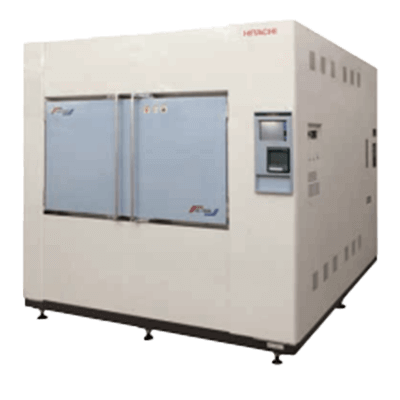What Is a Thermal Shock Equipment?

A thermal shock equipment is a device used to evaluate the effects of temperature changes on products and other items.
In thermal shock testing, the resistance of products, electronic components, materials, etc., to rapid temperature changes is assessed. The thermal shock equipment is equipped to expose specimens to alternating high and low-temperature environments, allowing for the execution of thermal shock tests through repetitive exposure cycles.
It is also referred to as a Heat Shock Test Apparatus or Thermal Shock Testing Machine.
Uses of Thermal Shock Testers
Thermal shock equipment is employed to evaluate products that demand high reliability, such as electronic components, and products where anticipated temperature variations during use, like in automobiles, need assessment. Specific examples of products include:
- Various semiconductor products (next-generation power semiconductors, flash memory, printed circuit boards, mounting boards, stacked circuits, etc.)
- Lithium-ion batteries, lithium capacitors
- Solar panels, solar cell modules
- Automotive displays
- Cables and harnesses
- Radiators
- Actuators
- Engine Control Units (ECUs)
- Inverters
- DCDC converters
- Motors and large motors
Evaluations conducted through thermal shock testing include:
- Bonding assessment through soldering (detection of defects such as cracks and fractures)
- Reliability assessment of printed circuit boards, mounting boards, and stacked circuits
- Accelerated testing to predict the lifespan of boards
- Reliability assessment due to material changes
- Durability evaluation of welded joints of dissimilar materials and confirmation of state changes due to differences in expansion and contraction rates
- Durability assessment of heat deformation (warping and cracking) in resin products
- Evaluation of condensation resulting from temperature changes
- Reproduction testing of malfunctions occurring after market distribution
Principle of Thermal Shock Testers
Thermal shock equipment creates low-temperature and high-temperature environments in the test area (test chamber) by using a medium (gas or liquid) tailored to the temperature conditions. Adjustments in the temperature of the medium, as well as its quantity, speed, and direction, are necessary to achieve the set temperature conditions.
By altering the temperature environment within the test area using the medium, the need for specimen movement is eliminated, reducing the impact on evaluation results from vibration and contact. Consequently, it enables the precise evaluation of reliability affected only by temperature conditions.
The range of settable temperatures generally spans from approximately -80°C to +300°C, allowing for the execution of tests under temperature conditions relevant to the intended purpose.
Types of Thermal Shock Equipment
There are two types of mediums used in thermal shock equipment: gas and liquid. Some devices can evaluate both temperature changes and condensation simultaneously.
Additionally, different devices vary in tank dimensions, load-bearing capacity, minimum and maximum temperatures, temperature change rates, etc. The maximum temperature, in particular, varies significantly depending on the product, with specifications such as 150°C, 200°C, and 300°C. Tank capacity can reach 600L for larger devices. Choosing the appropriate device based on the desired temperature range, product size, evaluation time, etc., is crucial.
1. Air Chamber Type
Air chamber-type thermal shock testing creates a temperature difference by exposing the specimen alternately to hot air and cold air. The structure typically includes adjacent cold and hot chambers next to the test chamber where the specimen is stored. Some air chamber-type products also involve moving the sample during the test.
Low-temperature and high-temperature air are alternately introduced into the test chamber, creating temperature changes. The mechanism of alternating air introduction results in a milder temperature change compared to liquid tank-type equipment. Additionally, tests can be conducted with the specimen powered.
2. Liquid Tank Type
Liquid tank-type thermal shock testing involves immersing the specimen alternately in hot and cold liquid. The testing machine’s mechanism moves the specimen between hot and cold tanks, applying temperature changes to the product. Consideration is given to minimizing the impact of movement, with temperature changes occurring within 10 seconds.
Refrigerants, such as non-freezing and non-boiling liquids with electrical insulating properties (e.g., glycol), are used. Immerse the specimen in the pre-set liquid to cause more abrupt temperature changes than the air chamber-type. Compared to air chamber-type devices, it is possible to shorten the testing time. However, caution is needed regarding the possibility of faults that may not occur in actual usage conditions.
3. Condensation Cycle Test
If the testing machine is equipped with a high-temperature humidifier, allowing humidity control within the device, it becomes possible to evaluate corrosion and potential malfunctions due to condensation, in addition to temperature changes. This type of test is particularly useful for testing items like automotive electrical equipment.
Other Information on Thermal Shock Equipment
1. Principles of Thermal Shock Testing
Various materials used in specimens subjected to thermal shock testing experience expansion and contraction due to temperature changes. Forces are applied at points where different materials meet, influenced by the difference in the coefficient of linear thermal expansion (CTE), which represents the relationship between temperature change and volume change. This force is stress.
As cycles of temperature differences between high and low temperatures are repeated, stress occurs, accumulates, and fatigues in various parts of the material. This can lead to phenomena such as cracking, peeling of coatings, loosening of screws, and ultimately, destruction. By testing this phenomenon, thermal shock testing evaluates how much resistance and strength the specimen has against temperature changes, providing an environment for reliability assessment.
2. Precautions when Using Thermal Shock Equipment
Reliability assessment typically spans several months depending on the temperature cycle range and the number of repetitions. Especially during accelerated testing, if the thermal shock equipment stops during the test, it significantly affects the evaluation itself.
Therefore, it is crucial to consider backup power facilities, such as batteries, in advance. In the event of a power outage due to natural phenomena like lightning or earthquakes, the evaluation process will stop. To avoid the potential of a test that took months to stop midway and start over from scratch, it is advisable to use a stable backup power source.